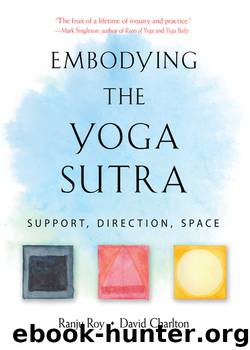Embodying the Yoga Sutra by Ranju Roy

Author:Ranju Roy
Language: eng
Format: epub
ISBN: 9781633411623
Publisher: Red Wheel Weiser
Ujjāyī in āsana
The basic methodology of breathing in āsana within this tradition is ujjāyī, sometimes called “throat control breathing.” Desikachar described ujjāyī as “that which clears the throat and masters the chest.”23 Its literal meaning is “giving mastery over the upward (movement)” and at a bodily level, ujjāyī acts as an expectorant, helping to dry excessive dampness from the trachea and thereby “master” the chest.
In ujjāyī, we create a restriction in the throat and there is a gentle hissing sound—it feels as if we are breathing directly in and out through the throat. This gentle friction, created by the turbulence as the flow of air passes through the restriction, can be used as a support for the movement, for the breath and for the attention. As a support for the movement, ujjāyī gives “body to the breath”: it makes the breath more substantial and helps the body float on its presence. As a support for the breath, ujjāyī helps to lengthen the breath, to make it more subtle and refined. Very importantly, we make a distinction between ujjāyī and the breath: ujjāyī is a tool which refines and controls the breath, but they are not the same. At its most subtle, we could even say that ujjāyī is a sign of the breath, an indication of the quality of the breath. Finally, as a support for the mind, ujjāyī gives the attention a tangible place to settle upon; it creates a gravitational pull that helps to keep the mind from scattering.
As ujjāyī is used throughout āsana practice, it becomes the default breath. But—and it's a big but—it has the potential to be abused. If ujjāyī becomes too habitual, we can easily switch off to it and it becomes an “alibi”: “Yes, I was present! I was doing ujjāyī!” While it can really help new practitioners to focus and refine their āsana practice, there is a potential danger for any experienced practitioner that it simply becomes a habit. For this reason, it may be helpful to use images and suggestions to keep our relationship with ujjāyī fresh. Ujjāyī can be seen as “a place of contact,” as “touching the whole body and not just the throat,” or indeed “a caress not a control.” It is easy to make the breath too rigid. Instead, we should let the breath play a little, to watch the interaction between breath and body and let that interaction be surprising sometimes, so that one moves in one way and the other in another. This helps maintain a freshness and joy with each breath we take in our āsana practice. Our ability to habituate, appropriate and abuse our relationship with what begins as being a genuine support is everywhere—yoga easily becomes sayoga!
Finally, although ujjāyī is the default breath in our practice (particularly in āsana and prāāyāma), it should not be practiced throughout the session nor as the default breath in our daily lives. When we are resting in between postures, or in śavāsana, for example, we should be able to let the breath be natural and unforced.
Download
This site does not store any files on its server. We only index and link to content provided by other sites. Please contact the content providers to delete copyright contents if any and email us, we'll remove relevant links or contents immediately.
Periodization Training for Sports by Tudor Bompa(8170)
Bodyweight Strength Training by Jay Cardiello(7841)
Born to Run: by Christopher McDougall(7065)
Inner Engineering: A Yogi's Guide to Joy by Sadhguru(6725)
Asking the Right Questions: A Guide to Critical Thinking by M. Neil Browne & Stuart M. Keeley(5635)
The Fat Loss Plan by Joe Wicks(4847)
Bodyweight Strength Training Anatomy by Bret Contreras(4613)
Yoga Anatomy by Kaminoff Leslie(4306)
Dynamic Alignment Through Imagery by Eric Franklin(4118)
Science and Development of Muscle Hypertrophy by Brad Schoenfeld(4089)
ACSM's Complete Guide to Fitness & Health by ACSM(3989)
Exercise Technique Manual for Resistance Training by National Strength & Conditioning Association(3956)
The Four-Pack Revolution by Chael Sonnen & Ryan Parsons(3932)
Bodyweight Strength Training: 12 Weeks to Build Muscle and Burn Fat by Jay Cardiello(3915)
The Ultimate Bodybuilding Cookbook by Kendall Lou Schmidt(3886)
Yoga Anatomy by Leslie Kaminoff & Amy Matthews(3863)
American Kingpin by Nick Bilton(3757)
Nutrition for Sport, Exercise, and Health by Spano Marie & Kruskall Laura & Thomas D. Travis(3715)
Yoga Therapy by Mark Stephens(3703)
